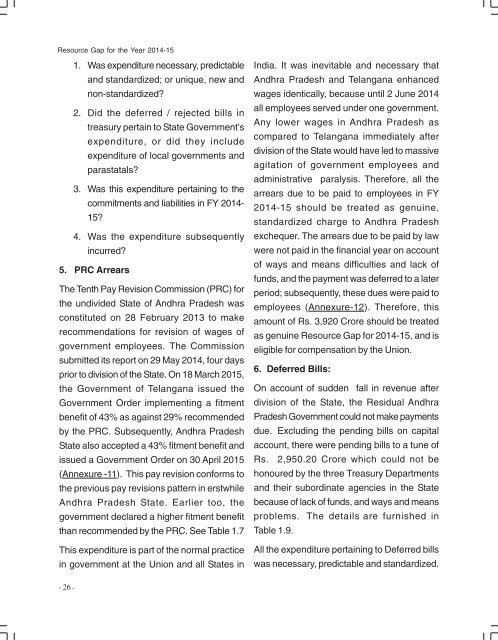AP Report 2019-final
You also want an ePaper? Increase the reach of your titles
YUMPU automatically turns print PDFs into web optimized ePapers that Google loves.
Resource Gap for the Year 2014-15<br />
1. Was expenditure necessary, predictable<br />
and standardized; or unique, new and<br />
non-standardized?<br />
2. Did the deferred / rejected bills in<br />
treasury pertain to State Government’s<br />
expenditure, or did they include<br />
expenditure of local governments and<br />
parastatals?<br />
3. Was this expenditure pertaining to the<br />
commitments and liabilities in FY 2014-<br />
15?<br />
4. Was the expenditure subsequently<br />
incurred?<br />
5. PRC Arrears<br />
The Tenth Pay Revision Commission (PRC) for<br />
the undivided State of Andhra Pradesh was<br />
constituted on 28 February 2013 to make<br />
recommendations for revision of wages of<br />
government employees. The Commission<br />
submitted its report on 29 May 2014, four days<br />
prior to division of the State. On 18 March 2015,<br />
the Government of Telangana issued the<br />
Government Order implementing a fitment<br />
benefit of 43% as against 29% recommended<br />
by the PRC. Subsequently, Andhra Pradesh<br />
State also accepted a 43% fitment benefit and<br />
issued a Government Order on 30 April 2015<br />
(Annexure -11). This pay revision conforms to<br />
the previous pay revisions pattern in erstwhile<br />
Andhra Pradesh State. Earlier too, the<br />
government declared a higher fitment benefit<br />
than recommended by the PRC. See Table 1.7<br />
This expenditure is part of the normal practice<br />
in government at the Union and all States in<br />
India. It was inevitable and necessary that<br />
Andhra Pradesh and Telangana enhanced<br />
wages identically, because until 2 June 2014<br />
all employees served under one government.<br />
Any lower wages in Andhra Pradesh as<br />
compared to Telangana immediately after<br />
division of the State would have led to massive<br />
agitation of government employees and<br />
administrative paralysis. Therefore, all the<br />
arrears due to be paid to employees in FY<br />
2014-15 should be treated as genuine,<br />
standardized charge to Andhra Pradesh<br />
exchequer. The arrears due to be paid by law<br />
were not paid in the financial year on account<br />
of ways and means difficulties and lack of<br />
funds, and the payment was deferred to a later<br />
period; subsequently, these dues were paid to<br />
employees (Annexure-12). Therefore, this<br />
amount of Rs. 3,920 Crore should be treated<br />
as genuine Resource Gap for 2014-15, and is<br />
eligible for compensation by the Union.<br />
6. Deferred Bills:<br />
On account of sudden fall in revenue after<br />
division of the State, the Residual Andhra<br />
Pradesh Government could not make payments<br />
due. Excluding the pending bills on capital<br />
account, there were pending bills to a tune of<br />
Rs. 2,950.20 Crore which could not be<br />
honoured by the three Treasury Departments<br />
and their subordinate agencies in the State<br />
because of lack of funds, and ways and means<br />
problems. The details are furnished in<br />
Table 1.9.<br />
All the expenditure pertaining to Deferred bills<br />
was necessary, predictable and standardized.<br />
- 26 -


